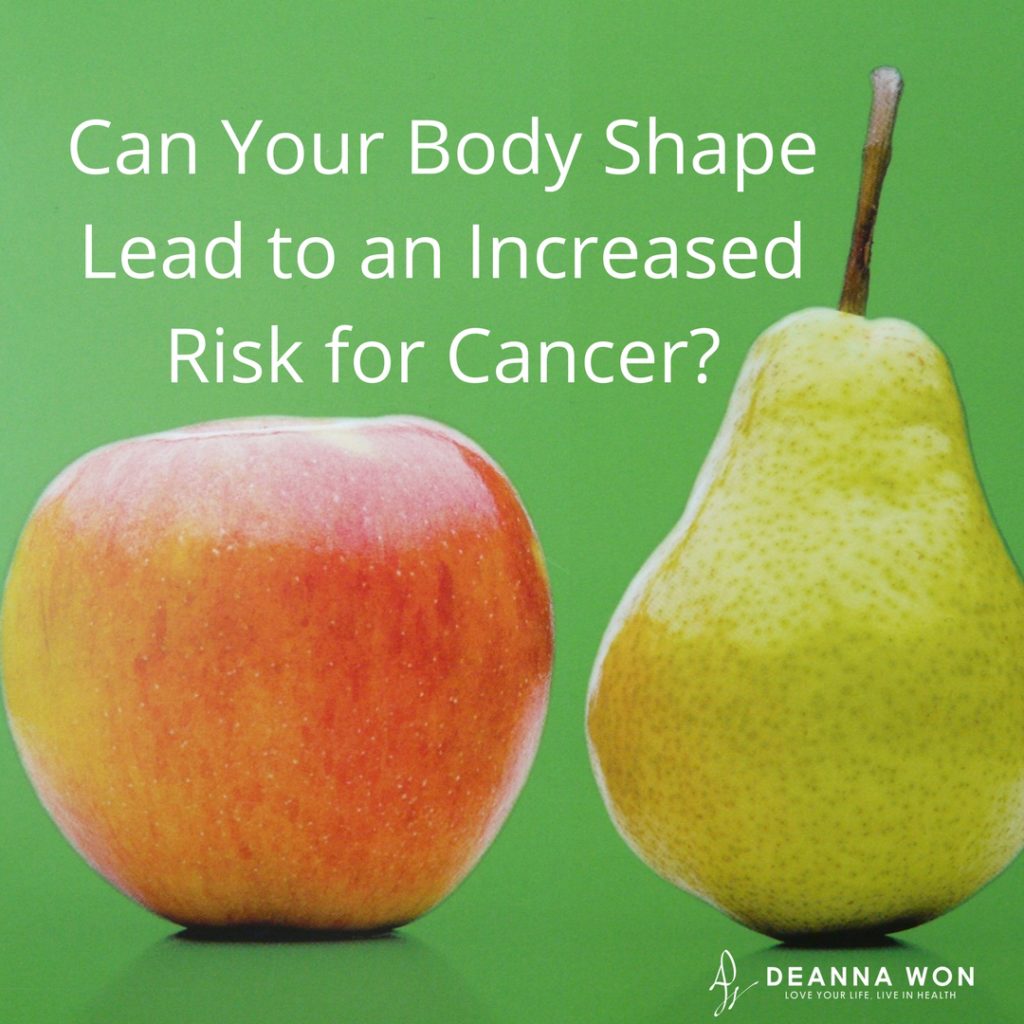As we age, some of us may begin to feel it increasingly challenging to maintain our waistline. We may think that perhaps those days of feeling fit and looking trim are gone. While some of you may already know that having excess abdominal fat can contribute to the onset of diabetes, you may not be aware of a not-so-fun fact about that where you carry that extra weight can actually increase your risk of cancer.
It’s commonly known that obesity, in general, is linked to increased risks for many chronic diseases, like cardiovascular disease. However, obesity can also lead to cancer. In fact, there are thirteen types of cancer that have been linked to obesity: breast cancer (in women after menopause), colon, uterine, esophageal, pancreatic, kidney, liver, stomach, gallbladder, ovarian, thyroid, myeloma (blood), and meningioma (a type of brain tumor).
Studies have shown that having excess fat cells contribute to the risk of cancer by producing hormones and growth factors that affect the function of your cells. Additionally, fat cells attract immune cells that contribute to chronic inflammation, thereby increasing the risk of cancer. Extra fat also contributes to changes in estrogen and testosterone levels, produce proteins that are released in the blood, and increase insulin levels. Higher insulin levels within cells lead to a higher rate of cell division, which is a common mechanism in the growth and spread of cancer cells.
You’re probably familiar with the “apple” vs. “pear” body shapes. In the “apple” shape, excess body fat is stored around the midsection around the abdomen of the body, whereas in the “pear” shape, the excess body fat is stored in lower portion of the body around the hips, buttocks, thighs. The “pear” shape is typically associated with estrogen dominance in women which can lead to poor thyroid health, not to mention some of the other hormonally-sensitive cancers. The “apple” shape has been linked to bowel, kidney, esophageal, pancreatic, and breast cancers.
I have an older friend by the name of Tonya, whose body shape would be categorized as “pear” shaped. In her seventies, Tonya loves to work with children as her own children and grandkids are all grown with families of their own. As a southern African American woman, Tonya grew up eating the traditional southern fare which consists of fried everything and gravy. With this type of diet, Tonya had continued to add additional weight to her body over the years. Tonya’s activity level was very low and her caloric intake far exceeded her activity level. Tonya did not realize the need to make the necessary changes to her diet until she had been diagnosed with thyroid cancer. If she had known that her diet and excessive weight could lead to this diagnosis, Tonya stated that she would have made the change years ago.
Fortunately, after making some drastic diet changes, Tonya has begun to lose weight and has also completely eradicated the cancer that was beginning to plague her body. Thankfully, she now understands how her decisions can affect her body and is taking the necessary steps to maintain her health so that she can, in her words, “be around a bit longer to play with my great-grandchildren.”
According to the American Cancer Society, 87% of all cancers in the United States are diagnosed in those 50 years of age or older. A good portion of this is due to poor diet and lack of activity. Along with age, there are a growing number of aches and pains that seem to appear out of nowhere, preventing people in this age group from engaging in physical activity the way they once did when they were younger. However, it’s increasingly important for us to continue to engage in physical activity on an ongoing basis.
The American Cancer Society states that, other than smoking, obesity is the biggest preventable cause of cancer. If we learn to modify our eating habits and increase our physical activity, we can decrease the excess weight and prevent the thirteen obesity-related cancers from taking root in our bodies.
As we become older, hormonal changes make it challenging to lose weight. Joints may become stiffer, and our metabolic rate continues to slow down with every passing decade. The following are a few tips to help you stay on top of your weight so that obesity-related diseases can be prevented.
Tips to Prevent Obesity-Related Diseases
Get Out Into Sunlight:
While it’s common to work out in a gym, it’s much better to exercise in the outdoors where you can get some sun exposure. You may be wondering about this since there is so much hype about the sunlight causing cancer. Additionally, you might not see the connection between sunlight and obesity.
However, sunlight, in fact, causes your body to become more sensitive to leptin, which is a hormone produced by the body’s fat cells. This is the hormone that allows you to feel full when you’ve eaten so that you know to stop eating.
So, when you become leptin resistant, where the cells in your body have become insensitive to leptin, it becomes easier to overeat. Leptin essentially regulates the rate at which we burn calories and how much fat we store in our bodies, so this is key to regulating our metabolism and weight, not to mention other chronic conditions like diabetes.
Sleep:
The average American gets about 6—7 hours of sleep per night. While you may not feel that sleep has anything to do with your waistline, it is actually critical in having the proper hormonal balance. Why is sleep so important? The time we are sleeping is actually when important hormones are produced. Research has shown that short sleepers have a 30 percent higher risk of gaining 30 pounds over the course of the study, compared to women who got 7 hours of sleep per night.
Lack of sleep also decreases levels of your fat-regulating hormone leptin while increasing the hunger hormone ghrelin. The resulting increase in hunger and appetite can easily lead to overeating and weight gain.
Eat healthier:
While you may not have the perfect diet, know that if you add more plant-based foods into your diet, you will increase the vitamins, minerals, enzymes, and other vital phytonutrients that becomes increasingly more important as we age.
Try adding fresh vegetables like salads and sprouts into your regular regimen since the enzymes contained in these vibrant green plants help to serve as catalysts for all our body functions. Cooked foods do not contain any enzymes, so it’s good idea to add fresh, raw vegetables into your daily diet.
Exercise consistently:
As we age, our metabolic rate decreases. Therefore, we will not be able to eat the same amount of food even just ten years ago. One easy way to increase your metabolism is to exercise on a consistent basis. At a minimum, take time to exercise 3-6 days each week.
Muscle loss is also a contributing factor to weight gain as we age. Muscle loss means slower metabolism. In order to improve your metabolic rate, pick up weight training. The goal is to build more muscle so that your metabolism will improve, helping you to burn the food that you eat as fuel rather than allowing your body to store it as fat.
In addition to resistance training, add low impact cardio to your workout regimen. You want to concentrate on exercises that aren’t too hard on your joints, like a brisk walk. If you’re not sure about the types of exercises you should be doing or the proper form to prevent injury, you may want to consult with a physical trainer. You want to push yourself enough to break a sweat without causing any injuries.
The American Cancer Society has published that approximately 41 out of 100 men and 38 out of 100 women will be diagnosed with cancer at some point in their lifetime. This is merely a predictor based on current trends. We can make changes in our lives that can prevent some forms of cancer from becoming a factor in our bodies. By educating yourself on the risks that can lead to cancer and making the appropriate changes, you are one step closer to leading a much happier and healthier life.
Ready to make your health a priority? Contact me here to schedule your consultation.
Sources:
http://www.obesity.org/obesity/resources/facts-about-obesity/cancer-obesity
http://www.prevention.com/fitness/lose-weight-after-50
http://www.lifeextension.com/Magazine/2016/6/The-Insulin-Cancer-Connection/Page-01
https://www.nature.com/bjc/journal/v116/n11/full/bjc2017106a.html
http://www.gallup.com/poll/166553/less-recommended-amount-sleep.aspx

